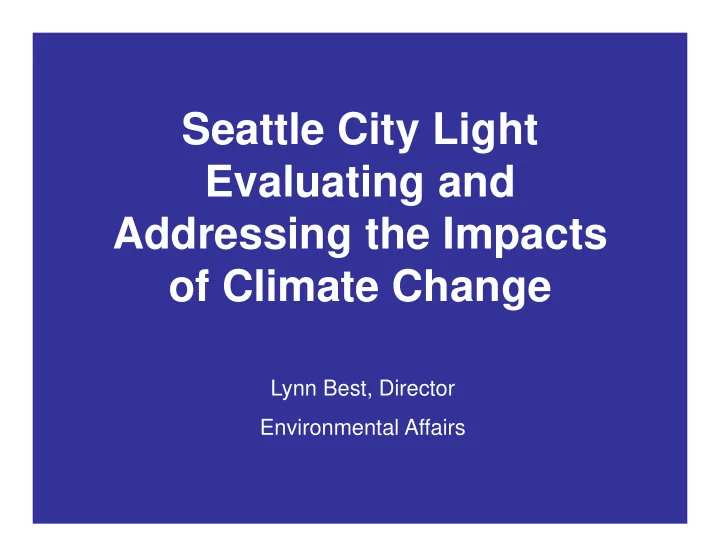

Seattle City Light Evaluating and Addressing the Impacts of Climate Change Lynn Best, Director Environmental Affairs
Seattle City Light • Municipal Electric Utility • 399,000 customers • About 90% of our power is hydro
Growing Concern about the Impacts of Climate on Our System • Effect on hydrogenation • Load • Operations • Fisheries Resources
Seattle City Light Skagit Project Finney Day Nookachamps
Historical Observations • Last 20 years – 11% lower April- September Ross Inflows • 2 week earlier spring runoff since 1970 • More frequent and larger floods on the Sauk River
Climate Change Historical Observations Reduced spring-summer inflow PDO Positive PDO Negative No official PDO Classification
Climate Change Impacts Detected Increased Sauk River Flood Magnitude 55,000 50,000 45,000 Flow (cfs) 40,000 35,000 30,000 25,000 20,000 1930s 1940s 1950s 1960s 1970s 1980s 1990s 2000s Decade
Climate Change Historical Observations Earlier Runoff Ross Runoff Starting and Ending Dates 8/28 8/13 7/29 7/14 Note: Trends of runoffs shifting to earlier starts and ends 6/29 6/14 Date Start day 5/30 End day Linear (Start day) 5/15 Linear (End day) 4/30 4/15 3/31 3/16 3/1 1971 1973 1975 1977 1979 1981 1983 1985 1987 1989 1991 1993 1995 1997 1999 2001 2003 2005 2007 2009 Year
Climate Change Historical Observations Increased Sauk River Flood Frequency
Modeling Analysis •Asked the Climate Impacts Group (CIG) for help •Downscaling GCMs •Site ‐ specific Projections for the Skagit
Skagit Projections Provided by CIG 1. Snowpack and Monthly Streamflow at 9 Gages Significant decline in snowpack (mean = 20%) More flow in late-fall and winter Lower summer flows 2. Extreme temperature and precipitation events More warm wet days = greater flood potential 3. Weekly water temperature at selected river and stream sites Substantial increases in summer water temperatures on Skagit River at Sedro Woolley and some eastside Ross Lake tributaries
Projected Number of Warm & Wet Days Warm, wet days increase significantly after mid 21 st century, driven primarily by warmer temperatures (some precipitation)
Extreme Flow Projections – Ross Reservoir Higher Flood Flows 23000 22000 Flow (cfs) 21000 historical 2040s 20000 19000 18000 20 50 100 Flood Return Interval (yrs) Lower Summer Low Flows 300 250 Flow (cfs) 200 150 100 historical 2020s 2040s 2080s Climate (A1B)
Stream temperature projections Stream temperature projections indicate some sites on the Skagit River will exceed thermal thresholds for core summer salmon & bull trout habitat (16 ° C –WA Department of Ecology)
Stream Temperature Projections Sedro Woolley Skagit at Sedro Woolley Skagit at Newhalem Stetattle Creek Stream temperature projections indicate some sites on the Skagit River will exceed thermal thresholds for core summer salmon habitat (16 ° C –WA Department of Ecology)
Downstream Impacts to Salmonids • 20-, 50- and 100-year floods increase • Increased chance of spill • Substantial decline in 7-day low-flow level • Scouring of salmon redds • Reduced salmonid survival
Concerns Will storm frequency and severity increase causing more spill and impacts to salmon?
Concerns • How will Project need to be operated to provide adequate instream flow during August and September to protect fish from thermal barriers or direct injury/mortality
Concerns Will glacier recession increase bedload deposition aggradation near mouths of tributaries? How will this affect generation and fish access?
Future Work • Adapt operations in response to: – Changing precipitation seasonal trends – Increased storms frequency and magnitude – Low summer flows – New Federal Energy Regulatory Commission (FERC) license (2025) – Corps of Engineers flood control management • Improve modeling and linkage of climate change projections with operational tools – Explore use of Distributed Hydrology-Soil-Vegetation model (DHSVM) and dynamic downscaling techniques – Improve understanding of tributary and glacier contribution – Develop operations optimization model • Operational constraints • Scenarios and sensitivity analyses • Daily time-step • Protect riverine ecosystem, endangered species, and anadromous fish
Seattle City Light Climate Program • Goal is to be GHG neutral • Policy Direction from Mayor and Council - “Earth Day” Resolution 2000 - “Net Zero Strategy” Resolution in 2001
How are we meeting the goal • Conservation – 1 st Priority • Renewables – 2 nd Priority • Divest Fossil Fuel • Purchase Offsets
Energy Conservation
Conservation Program • Operating conservation programs for 33 years • Reduced our load by 11% • Avoiding over 600,000 metric tons of CO2 per year • From 1991-2004, the investment in conservation totaled $486 million
Renewables
Renewables • Stateline Wind - 3% to 4% of load - Avoids over 200,000 metric tons CO2/yr • Burlington Biomass - Average 14,000 MWh/yr • Columbia Ridge Landfill - Anticipated 50,000 MWh/yr - Avoids 30,000 metric tons CO2/yr
City Light Greenhouse Gas Emissions • Primarily from purchased power • Small amount from operations: vehicles, airline travel, SF6 • Reported to The Climate Registry (TCR) • TCR has protocols for calculating and reporting GHG emissions • Electric Utilities have additional protocols due to the complexity of this industry and its contribution to GHG emissions
2010 Inventory Remaining Emissions – Metric Tons CO2 • High Ross 3,400 • BPA Block 139,538 • Market Purchases 60,884 • Distribution Losses 3,781 • Non-Generation Sources – Airline travel 1,471 – Vehicle Fleet 4,220 – Natural Gas (heat) 243 – SF6/Refrigerant 420 • TOTAL 213,197
GHG Offset Criteria • Verifiable • Additional • Reasonably Priced • Preference for Local • Co-Benefits: environment, economic • Replicability – can be expanded to other locations
City Light Offset Projects • Recent offset project types: • Dairy Methane Capture/Electricity Generation • Improved manure management • Landfill Gas Capture and Destruction • Other offset projects include: • Biodiesel – City Fleet, SPU/Garbage Truck, King Co. buses, WA Ferries • Shore Power – Princess and Holland Lines cruise ships • Dupont (HFC-23) • Cement Material Substitution – with the Climate Trust
Shore Power
Cruise Ship Connection
Recommend
More recommend